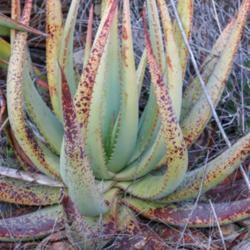I welcome all the speculation about color because the reason I took the picture in the first place was to document the color.

This plant undergoes 2 different types of color change in reaction to stress, primarily drought stress in this case. One is a general orange or brownish hue like in the second picture above, also documented in the database entry with a plant in habitat. That color will rapidly reverse to green within about 2 weeks after proper rainfall. The difference is quite striking. We are now in our rainy season, so the reversal has taken place already.
The second type of color change in response to stress is a more permanent type of sunburn, ie. the dark brown spots that are documented in the photo, that does not reverse with rehydration. You can see in the photo that the newer, younger leaves lack this color and are plain green. These leaves are new since the peak of summer. This plant shows a pretty striking seasonal growth pattern in our climate and the leaves start out pristine before their first summer. I do not view the dark brown spots as a sign of anything wrong, just evidence that the plant has been through hard times.
Some other observations...
The orangey aloe in the second picture is a different plant, not the one in the original picture. I have yet to upload a proper picture of the bigger plant during the peak of summer drought. Those 2 plants are growing together on a rocky hillside here in a climate that very much resembles their habitat (arid climate, dry summers, winter rainfall, lots of fog). I meant for them to flower together and then grow the species from seed, but that has yet to happen, because they skip a flowering season when it doesn't rain enough.
Bear in mind that we experience an annual summer drought that is several months long, and our previous rainy season (last winter) was the driest in recorded history (maybe 3 inches of total rainfall). So this big plant (current picture at top) is coming out of a really difficult place water-wise.
Aloe rust is something that basically does not happen here, at least not as it is described above. I think lots of air flow and sunlight probably work wonders to keep it at bay. Maybe it's a greenhouse thing.


